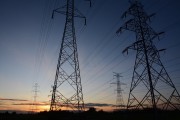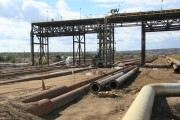Note: A similar Op Ed was published in the context of Ontario and Nationally.
Federal Natural Resources Minister Gary Lunn has become an increasingly vocal promoter of the idea of using nuclear power as an alternative energy source to natural gas for developing Alberta's oilsands. Indeed, he has stated that it is not a matter of "if," but "when" a nuclear reactor will be built to supply energy to oilsands production facilities. Lunn has backed his proposals with statements that nuclear energy is "emission-free," produces "no greenhouse gases," and "there's no pollutants going out (with) the energy."
Leaving aside the consideration that no oilsands company has actually made any kind of commitment to pursuing the use of nuclear power, and that the technical and economic viability of nuclear in an oilsands context is at best unproven, Minister Lunn's claims beg answers to some serious questions.
Is nuclear energy clean? Minister Lunn claims that nuclear power generation produces no greenhouse gases and air pollution. In reality, nuclear power, like other non-renewable energy sources, is associated with severe environmental impacts. Each stage of the nuclear energy production process, from uranium mining to power plant operation, generates large amounts of radioactive and otherwise hazardous wastes that will require care, in some cases for hundreds of thousands of years, for safety, security and environmental reasons.
The process also pollutes surface water and groundwater water with radioactive and hazardous pollutants. Water pollution from uranium mines and mills has been found by Health Canada and Environment Canada to meet the definition of a toxic substance for the purposes of the Canadian Environmental Protection Act. Canadian nuclear power plants have had routine and accidental releases to surface and groundwater of radionuclides, particularly tritium.
Significant releases of hazardous air pollutants, radionuclides and smog and acid rain-causing pollutants occur throughout the process of mining and producing uranium fuel for nuclear power stations. Greenhouse gases, particularly carbon dioxide, are produced at each stage of the nuclear energy cycle. Greenhouse gas emissions occur during the construction of reactors, as a result of the operation of equipment in the uranium mining process, the milling of uranium ore, mill tailings management activities, and refining and conversion operations. Greenhouse gas emissions also result from the transportation of uranium between milling, refining and conversion facilities and transportation required in the management of waste nuclear fuel and other radioactive wastes.
Is nuclear energy affordable? Ask Ontario electricity consumers, who are greeted with a "debt retirement charge" on their electricity bills every month to pay off $20 billion in "stranded" debt, mostly left behind by Ontario Hydro's perpetually over budget and under performing nuclear plants. That's to say nothing of the financial guarantees that would have to be provided by Alberta taxpayers for waste fuel management, decommissioning costs, and in the event of a serious accident, any damage to the environment, public health or the economy over $75 million. It has been estimated that the economic damages from a major accident at the Darlington Ontario nuclear plant east of Toronto would be in the range of $1 trillion. In addition to its immediate human and environment costs, a major nuclear accident in the oilsands could end their development for centuries.
Nor, as its proponents claim, is nuclear power subject to "stable" fuel prices. The world price for uranium, the fuel for nuclear power plants, has risen by a factor or more than six over the past five years.
Is nuclear energy reliable? Nuclear proponents point to their improved performance this year. Just don't ask them about the performance over the last couple decades. The Ontario CANDU reactor fleet, for example, has been subject to severe performance and reliability problems. Some Ontario facilities have had average operating capacities below 40 per cent rather than the expected 85 - 90 per cent range. Reactors expected to have operational lifetimes in the range of 40 years have turned out to require major refurbishments after approximately 25 years of service. Refurbishment projects themselves have run seriously over budget and behind schedule.
Nuclear energy's environmental, economic and reliability challenges, along with security, accident and weapons proliferation risks that are simply not shared by any other energy source, place nuclear energy in a unique category relative to all other energy supply options.
Albertans will want to think long and hard about these challenges and risks before they even consider Minister Lunn's proposals for nuclear power in the oilsands. Safer, cheaper and more reliable options are on the horizon. These range from the use of fuels derived from the gasification of petroleum coke wastes already produced by the oilsands, and capture and geological storage of greenhouse gases resulting from their use, to the use of deep geothermal energy sources. These cheaper, cleaner, more reliable options should be the focus of Albertans' attention.







